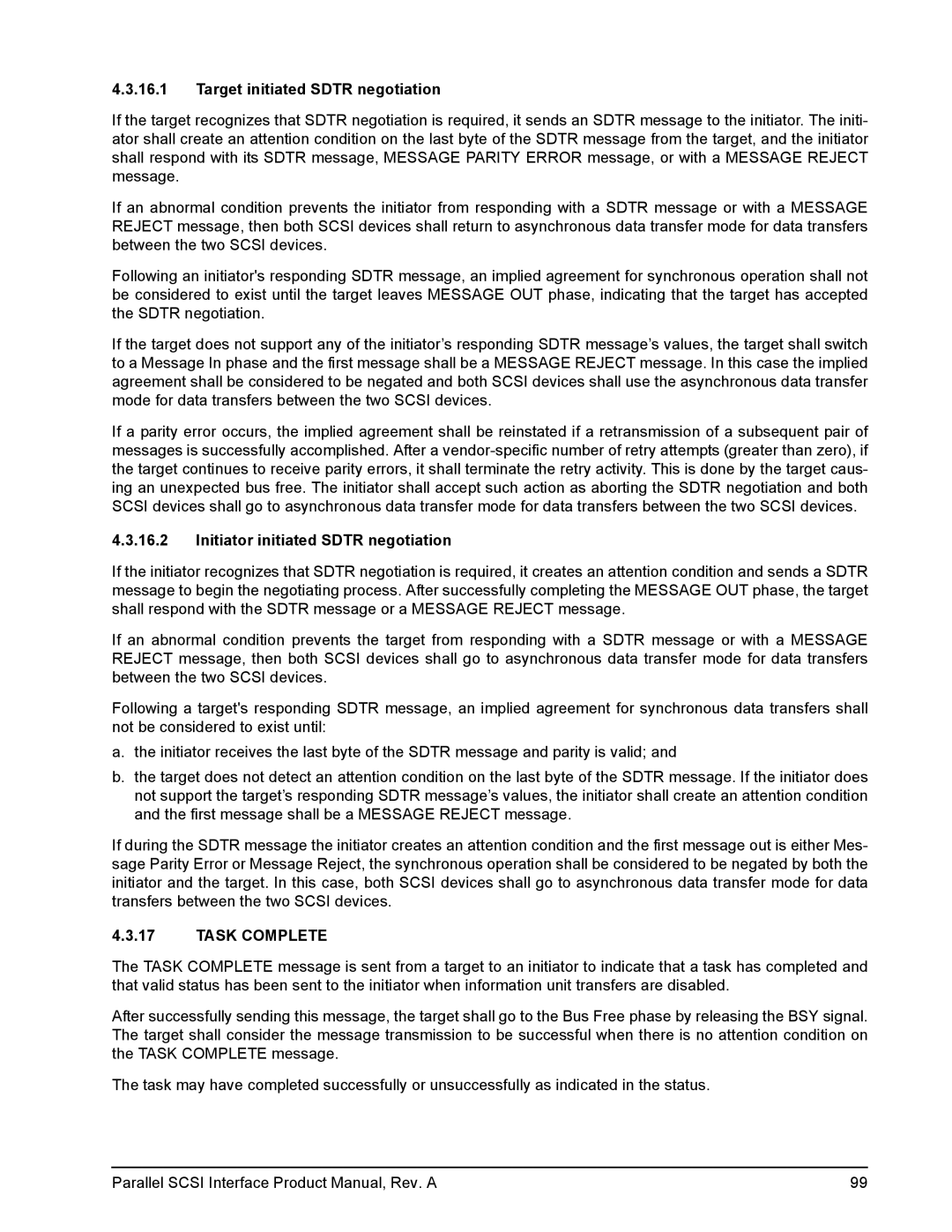4.3.16.1Target initiated SDTR negotiation
If the target recognizes that SDTR negotiation is required, it sends an SDTR message to the initiator. The initi- ator shall create an attention condition on the last byte of the SDTR message from the target, and the initiator shall respond with its SDTR message, MESSAGE PARITY ERROR message, or with a MESSAGE REJECT message.
If an abnormal condition prevents the initiator from responding with a SDTR message or with a MESSAGE REJECT message, then both SCSI devices shall return to asynchronous data transfer mode for data transfers between the two SCSI devices.
Following an initiator's responding SDTR message, an implied agreement for synchronous operation shall not be considered to exist until the target leaves MESSAGE OUT phase, indicating that the target has accepted the SDTR negotiation.
If the target does not support any of the initiator’s responding SDTR message’s values, the target shall switch to a Message In phase and the first message shall be a MESSAGE REJECT message. In this case the implied agreement shall be considered to be negated and both SCSI devices shall use the asynchronous data transfer mode for data transfers between the two SCSI devices.
If a parity error occurs, the implied agreement shall be reinstated if a retransmission of a subsequent pair of messages is successfully accomplished. After a
4.3.16.2Initiator initiated SDTR negotiation
If the initiator recognizes that SDTR negotiation is required, it creates an attention condition and sends a SDTR message to begin the negotiating process. After successfully completing the MESSAGE OUT phase, the target shall respond with the SDTR message or a MESSAGE REJECT message.
If an abnormal condition prevents the target from responding with a SDTR message or with a MESSAGE REJECT message, then both SCSI devices shall go to asynchronous data transfer mode for data transfers between the two SCSI devices.
Following a target's responding SDTR message, an implied agreement for synchronous data transfers shall not be considered to exist until:
a.the initiator receives the last byte of the SDTR message and parity is valid; and
b.the target does not detect an attention condition on the last byte of the SDTR message. If the initiator does not support the target’s responding SDTR message’s values, the initiator shall create an attention condition and the first message shall be a MESSAGE REJECT message.
If during the SDTR message the initiator creates an attention condition and the first message out is either Mes- sage Parity Error or Message Reject, the synchronous operation shall be considered to be negated by both the initiator and the target. In this case, both SCSI devices shall go to asynchronous data transfer mode for data transfers between the two SCSI devices.
4.3.17TASK COMPLETE
The TASK COMPLETE message is sent from a target to an initiator to indicate that a task has completed and that valid status has been sent to the initiator when information unit transfers are disabled.
After successfully sending this message, the target shall go to the Bus Free phase by releasing the BSY signal. The target shall consider the message transmission to be successful when there is no attention condition on the TASK COMPLETE message.
The task may have completed successfully or unsuccessfully as indicated in the status.
Parallel SCSI Interface Product Manual, Rev. A | 99 |
